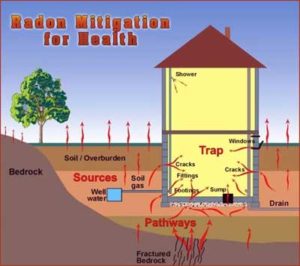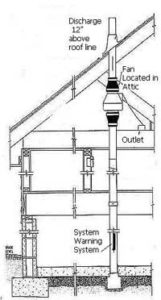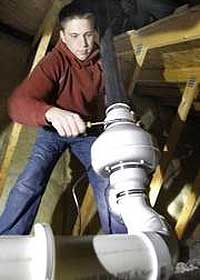Radon Testing and Mitigation Services
 Radon is a naturally occurring radioactive gas, which is generated from the decay of uranium that is found in nearly all soils. Radon typically moves up through the ground and enters buildings through cracks in foundations and walls, construction joints, gaps in suspended floors and around service pipes, and even through well water. Buildings traps the radon where it can build up to dangerous levels. All types of buildings can have a radon problem; new and old buildings, well-sealed and drafty buildings, and buildings with or without basements.
Radon is a naturally occurring radioactive gas, which is generated from the decay of uranium that is found in nearly all soils. Radon typically moves up through the ground and enters buildings through cracks in foundations and walls, construction joints, gaps in suspended floors and around service pipes, and even through well water. Buildings traps the radon where it can build up to dangerous levels. All types of buildings can have a radon problem; new and old buildings, well-sealed and drafty buildings, and buildings with or without basements.
Radon is estimated to cause thousands of deaths each year. That’s because exposure to radon can damage lung tissue and lead to lung cancer. In fact, the Surgeon General has warned that radon is the second leading cause of lung cancer; the first being tobacco. This is why radon testing is being conducted as part of the due diligence process in almost all residential and commercial building transactions. Schools and child daycare facilities are being mandated to test for radon and, if necessary, install mitigation systems.
 Law states that the average outdoor level of radon is 0.4 pico curies per liter of air (pCi/L), and therefore set this level as a target for indoor air. It has been determined that this is not a realistic target. Two-thirds of all buildings exceed this level. Because of this, the EPA was given the responsibility of setting practical guidelines. The EPA set an indoor air action level at 4 pCi/L. At or above this level the EPA recommends that corrective actions be taken. This does not imply that a level below 4.0 pCi/L is considered acceptable. It is dangerous to be exposed to any level of radon.
Law states that the average outdoor level of radon is 0.4 pico curies per liter of air (pCi/L), and therefore set this level as a target for indoor air. It has been determined that this is not a realistic target. Two-thirds of all buildings exceed this level. Because of this, the EPA was given the responsibility of setting practical guidelines. The EPA set an indoor air action level at 4 pCi/L. At or above this level the EPA recommends that corrective actions be taken. This does not imply that a level below 4.0 pCi/L is considered acceptable. It is dangerous to be exposed to any level of radon.
 In most cases, the best approach for reducing radon levels is to install a sub-slab depressurization system. This type of system does not require major changes to the building. This system is designed to collect the radon from below the building floor and from outside the foundation before the gas enters the building. The radon is then forced through a pipe system and out a stack into the atmosphere.
In most cases, the best approach for reducing radon levels is to install a sub-slab depressurization system. This type of system does not require major changes to the building. This system is designed to collect the radon from below the building floor and from outside the foundation before the gas enters the building. The radon is then forced through a pipe system and out a stack into the atmosphere.
Total Environmental & Safety, LLC’s (Total) professional associates have the knowledge and experience to develop and implement a radon testing initiative, and if necessary, design and install a mitigation system that meets all regulatory requirements in a cost effective and timely manner.


